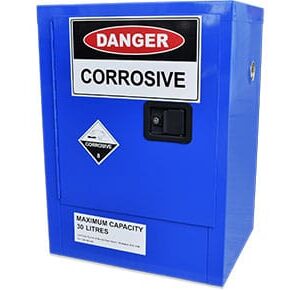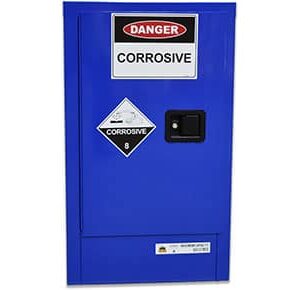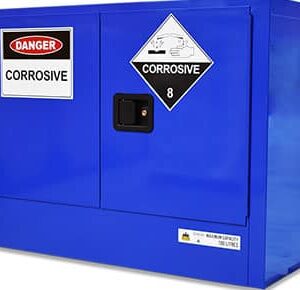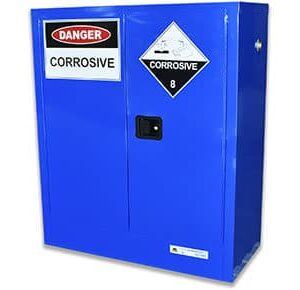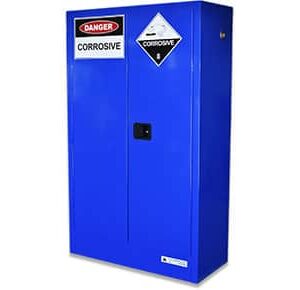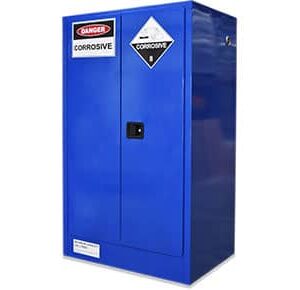Storage Cabinets for Indoor Corrosive & Chemical Solutions
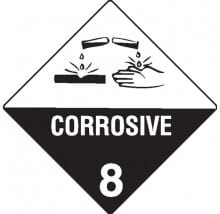
Features of our range of Corrosive/Chemical safety cabinets include; self-closing doors and, built in vents with flash arrestors, spill containment sump with drain and a glossy blue, lead-free epoxy/polyester powder-coat finish.
With sizes ranging from 30L (ideal for placing on or under work benches), to 350L capacity, we have the safety cabinets to meet your requirements.
Search Products:
Categories:
Showing all 7 results
-
30 Litre Indoor Chemical Storage Cabinet/Corrosive Substances Cabinet
$1,385.00 + GST Add to cart -
60 Litre Indoor Chemical Storage Cabinet/Corrosive Substances Cabinet
$1,445.00 + GST Add to cart -
100 Litre Indoor Chemical Storage Cabinet/Corrosive Substances Cabinet
$1,740.00 + GST Add to cart -
160 Litre Indoor Chemical Storage Cabinet/Corrosive Substances Cabinet
$1,895.00 + GST Add to cart -
250 Litre Indoor Chemical Storage Cabinet/Corrosive Substances Cabinet
$2,195.00 + GST Add to cart -
350 Litre Indoor Chemical Storage Cabinet/Corrosive Substances Cabinet
$2,695.00 + GST Add to cart -
450 Litre Indoor Chemical Storage Cabinet/Corrosive Substances Cabinet
$4,240.00 + GST Add to cart
Description
Corrosive substances are chemicals that can potentially damage your property and the environment, and can also be very hazardous to people as well.
Depending on their potency, the hazardous property of various corrosive chemicals is their propensity to dissolve matter through chemical reactions.
Apart from acids and bases, there are other substances that can be corrosive as well. Substances like chlorine, bromine, and other oxidising agents are likewise just as corrosive. Check the Substances Material Safety Data Sheet or (MSDS) and product labels to see if the substances you are handling have corrosive properties.
Special care has to be taken when handling, working, and storing corrosive materials Where corrosive materials are concerned, damage begins at first contact with skin or any surface. Brief or prolonged exposure can lead to some rather unpleasant ailments, and may even cause death, if left untreated.
Once exposed, the extent of damage or injuries these corrosive substances may bring are entirely dependent on the strength and concentration, as well as the duration of contact of the substance or substances involved. Do note that exposure to corrosive substances and chemicals can be toxic and can cause other health issues if proper treatment is not done immediately.

Features
Constructions: Wholesale Safety Storage Australia’s Indoor Corrosive | Chemical Storage Cabinets are designed with a double wall construction with the inclusion of an integrated 40 mm thermal barrier.
Our cabinet’s floor, walls, doors, and roof are made with double walled steel. The gaps in between the steel panels are filled with fire-resistant insulation that adds another level of protection from radiant heat emanating from either internal or external fires that may occur.
1. Heat-Resistant Superstructure for Enhanced Fire Protection
2. Built-in Ventilation and Galvanized Steel Shelving for Maximum Durability
3. Chemically Resistant Thermoplastic Coating for Long-Term Shelf Protection
4. Grounding Connector for Safe Static and Electrical Discharge Prevention
5. Pre-Applied Safety Signage for Compliance with Australian Standards
6. Deep Liquid-Tight Sump for Effective Containment of Spills
7. Liquid-Tight Sump for Optimal Spill Containment in All Cabinet Sizes
8. Perforated Shelves and Venting Ports for Improved Airflow and Fume Control
9. Adjustable Feet for Stability on Uneven Surfaces
10. UV-Stabilized Powder Coating for Superior Durability and Rust Prevention
Handling Corrosive Materials
If you accidentally swallow any corrosive substance, it can pretty much burn whatever internal organ it touches or passes through. Contact with skin is the most common accidental interaction with corrosive substances. This can lead to immediate irritation, dryness, to severe damage from the point of contact. Prolonged contact and exposure can also potentially lead to extreme effects such as systemic organ damage or failure.

Apart from damage to metals and other materials, one element that you have to look out for is the presence of hydrogen. It is the common byproduct of corrosive reactions. Hydrogen is highly combustible and can cause fires and even explosions from a single spark. An unforgettable example of this is the case of the Hindenburg. The blimp used hydrogen, which, as we mentioned, is highly flammable and explosive once ignited.
For reasons such as these, the handling and proper storage of corrosive chemicals is of utmost urgency, as it is also of prime importance in handling flammable materials. We at Wholesale Safety Storage Australia only offer Indoor Corrosive | Chemical Storage that is fully compliant with strict Australian Standards.
